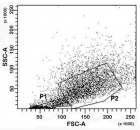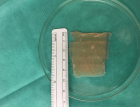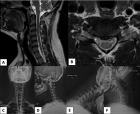Abstract
Research Article
Intraepidermal Injections of Autologous Epidermal Cell Suspension: A new promising approach to Dermatological Disorders. Preliminary Study
Fabio Rinaldi*, Elisa Borsani, Luigi Fabrizio Rodella, Elisabetta Sorbellini, Rita Rezzani, Daniela Pinto, Barbara Marzani, Giovanna Tabellini and Mariangela Rucco
Published: 07 December, 2017 | Volume 1 - Issue 1 | Pages: 066-070
Regenerative medicine is a modern approach of dermatological treatment, using Epidermal Cells of the interfollicular epidermis (ESCs) for their effect in skin regeneration in chronic ulcers and burns, melanoma, vitiligo, junctional epidermolysis bullosa. Intraepidermal injections of autologous epidermal cell suspension can be a new and very promising treatment for many other cutaneous disorders as non-scarring alopecia (Alopecia Areata, Androgenic Alopecia) or scarring alopecia (Lichern Plano Pilaris alopecia, Discoid Lupus Erithematosus alopecia), anti-aging therapies. The intraepidermal injection of an autologous epidermal cell suspension is a simple, fast and safe surgical procedure: a small, thin portion of the epidermis of the patient undergoes a treatment where a suspension with all the cells collected from the epidermis and cultured for 7 days is injected into the skin. Our preliminary study shows that a suspension contains a significant number of viable cells that survive at day 7 in culture.
Our research is ongoing and is focusing on the typing of the different cells in the suspension and evaluation of the presence and the nature of stem cells.
Read Full Article HTML DOI: 10.29328/journal.jsctt.1001007 Cite this Article Read Full Article PDF
References
- Jackson CJ, Tønseth KA, Utheim TP. Cultured epidermal stem cells in regenerative medicine. Stem Cell Res Ther. 2017; 8: 155. Ref: https://goo.gl/x7nfCo
- University of Chicago. Chemotherapy plus peripheral stem cell transplantation in treating patients with melanoma or metastatic kidney cancer. ClinicalTrials.gov. 2014; NCT00004135.
- Hoerter JD, Bradley P, Casillas A, Chambers D, Weiswasser B, et al. Does melanoma begin in a melanocyte stem cell? J Skin Cancer. 2012. Ref: https://goo.gl/hxe7af
- Ann & Robert H Lurie Children’s Hospital of Chicago. Immunoablative mini transplant (hematopoietic peripheral blood stem cell transplant [HPBSC]). ClinicalTrials.gov. 2014; NCT00179764. Ref: https://goo.gl/xzTavg
- Fred Hutchinson Cancer Research Center. Combination chemotherapy, total-body irradiation, peripheral stem cell transplantation, and lymphocyte infusion in treating patients with Stage IV melanoma. ClinicalTrials.gov 2011; NCT00006233. Ref: https://goo.gl/RAzGH2
- Khodadadi L, Shafieyan S, Sotoudeh M, Dizaj AV, Shahverdi A, et al. Intraepidermal injection of dissociated epidermal cell suspension improves vitiligo. Arch Dermatol Res. 2010; 302: 593-599. Ref: https://goo.gl/PCCV95
- Van Geel N, Ongenae K, Naeyaert JM. Surgical techniques for vitiligo: a review. Dermatology. 2001; 202: 162-166. Ref: https://goo.gl/QJCLm9
- Lee DY, Lee JH. Epidermal grafting for vitiligo: a comparison of cultured and noncultured grafts. Clin Exp Dermatol. 2010; 35: 325-326. Ref: https://goo.gl/WMpBw6
- Guerra L, Capurro S, Melchi F, Primavera G, Bondanza S, et al. Treatment of "stable" vitiligo by Timedsurgery and transplantation of cultured epidermal autografts. Arch Dermatol. 2000; 136: 1380-1389. Ref: https://goo.gl/BZqtQk
- Matsuzaki K, Kumagai N. Treatment of vitiligo with autologous cultured keratinocytes in 27 cases. Eur J Plast Surg. 2013; 36: 651-656. Ref: https://goo.gl/SWQegA
- Mavilio F, Pellegrini G, Ferrari S, Di Nunzio F, Di Iorio E, et al. Correction of junctional epidermolysis bullosa by transplantation of genetically modified epidermal stem cells. Nat Med. 2006; 12: 1397-1402. Ref: https://goo.gl/3rabfK
- Trink A, Sorbellini E, Bezzola P, Rodella L, Rezzani R, et al. A randomized, double-blind, placebo- and active-controlled, half-head study to evaluate the effects of platelet-rich plasma on alopecia areata. Br J Dermatol. 2013; 169: 690-694. Ref: https://goo.gl/8uhusp
- Allen TD, Potten CS. Fine-structural identification and organization of the epidermal proliferative unit. J Cell Sci. 1974; 15: 291-319. Ref: https://goo.gl/G1e472
- Ghazizadeh S, Taichman LB. Multiple classes of stem cells in cutaneous epithelium: a lineage analysis of adult mouse skin. The EMBO Journal. 2001; 20: 1215-1222. Ref: https://goo.gl/t4wVRJ
- Purba TS, Haslam IS, Poblet E, Jiménez F, Gandarillas A, et al. Human epithelial hair follicle stem cells and their progeny: current state of knowledge, the widening gap in translational research and future challenges. Bioassays. 2014; 36: 513-525. Ref: https://goo.gl/4Vte5v
- Gottipamula S, Saraswat SK, Sridhar KN. Comparative study of isolation, expansion and characterization of epithelial cells. Cytotherapy. 2017; 19: 263-271. Ref: https://goo.gl/CYY5kc
- De Kock J, Rodrigues RM, Buyl K, Vanhaecke T, Rogiers V. Human Skin-Derived Precursor Cells: Isolation, Expansion, and Hepatic Differentiation. Methods Mol Biol. 2015; 1250: 113-122. Ref: https://goo.gl/9qhxvg
- Fujimori Y, Izumi K, Feinberg SE, Marcelo CL. Isolation of small-sized human epidermal progenitor/stem cells by Gravity Assisted Cell Sorting (GACS). J Dermatol Sci. 2009; 56: 181-187. Ref: https://goo.gl/cAawnP
- Kaviani M, Geramizadeh B, Rahsaz M, Marzban S. Considerations in the improvement of human epidermal keratinocyte culture in vitro. Exp Clin Transplant. 2015; 13: 366-370. Ref: https://goo.gl/BY7Gsu
- Li A, Simmons PJ, Kaur P. Identification and isolation of candidate human keratinocyte stem cells based on cell surface phenotype. Proc Natl Acad Sci USA. 1998; 95: 3902-3907. Ref: https://goo.gl/A6EEhY
Figures:

Figure 1

Figure 2

Figure 3
Similar Articles
-
The Femoral Head of Patients with Hip Dysplasia is not as Osteogenic as Iliac Crest Bone LocationPhilippe Hernigou*,Yasuhiro Homma,Arnaud Dubory,Jacques Pariat,Damien Potage,Charles Henri Flouzat Lachaniette,Nathalie Chevallier,Helene Rouard . The Femoral Head of Patients with Hip Dysplasia is not as Osteogenic as Iliac Crest Bone Location. . 2017 doi: 10.29328/journal.jsctt.1001001; 1: 001-007
-
Rhabdomyoblasts in Pediatric Tumors: A Review with Emphasis on their Diagnostic UtilityGiuseppe Angelico*,Eliana Piombino,Giuseppe Broggi,Fabio Motta,Saveria Spadola. Rhabdomyoblasts in Pediatric Tumors: A Review with Emphasis on their Diagnostic Utility . . 2017 doi: 10.29328/journal.jsctt.1001002; 1: 008-016
-
Surgical Implantation of Stem Cells in Heart Failure Patients due to Idiophatic CardiomyopathyBenetti Federico*,Natalia Scialacomo,Enrique Mariani,Luis Geffner,Bruno Benetti Eng1,Daniel Brusich,Yan Duarte. Surgical Implantation of Stem Cells in Heart Failure Patients due to Idiophatic Cardiomyopathy. . 2017 doi: 10.29328/journal.jsctt.1001003; 1: 017-027
-
Enhancing adipose stem cell chondrogenesis: A study on the roles of dexamethasone, transforming growth factor β3 and ascorbate supplements and their combinationBernard J Van Wie*,Arshan Nazempour##,Chrystal R Quisenberry##,Nehal I Abu-Lail. Enhancing adipose stem cell chondrogenesis: A study on the roles of dexamethasone, transforming growth factor β3 and ascorbate supplements and their combination. . 2017 doi: 10.29328/journal.jsctt.1001004; 1: 028-051
-
Arid3a regulates mesoderm differentiation in mouse embryonic stem cellsHaley O Tucker*,Melissa Popowski,Bum-kyu Lee,Vishwanath R Iyer,Cathy Rhee. Arid3a regulates mesoderm differentiation in mouse embryonic stem cells. . 2017 doi: 10.29328/journal.jsctt.1001005; 1: 052-062
-
Nicotinamide as a treatment option of Age-Related Macular DegenerationChristine Skerka*,Yuchen Lin,Peter F. Zipfel. Nicotinamide as a treatment option of Age-Related Macular Degeneration. . 2017 doi: 10.29328/journal.jsctt.1001006; 1: 063-065
-
Intraepidermal Injections of Autologous Epidermal Cell Suspension: A new promising approach to Dermatological Disorders. Preliminary StudyFabio Rinaldi*,Elisa Borsani,Luigi Fabrizio Rodella,Elisabetta Sorbellini,Rita Rezzani,Daniela Pinto,Barbara Marzani,Giovanna Tabellini,Mariangela Rucco. Intraepidermal Injections of Autologous Epidermal Cell Suspension: A new promising approach to Dermatological Disorders. Preliminary Study. . 2017 doi: 10.29328/journal.jsctt.1001007; 1: 066-070
-
Stemness of Mesenchymal Stem CellsTong Ming Liu*. Stemness of Mesenchymal Stem Cells. . 2017 doi: 10.29328/journal.jsctt.1001008; 1: 071-073
-
Stem cells in heart failure some considerationsFederico Benetti*,Natalia Scialacomo,Bruno Benetti. Stem cells in heart failure some considerations. . 2018 doi: 10.29328/journal.jsctt.1001009; 2: 001-003
-
Stem cells in patients with heart failure experienceBenetti Federico*,Natalia Scialacomo. Stem cells in patients with heart failure experience. . 2018 doi: 10.29328/journal.jsctt.1001010; 2: 004-014
Recently Viewed
-
Fostering Pathways and Creativity Responsible for Advancing Health Research Skills and Knowledge for Healthcare Professionals to Heighten Evidence-Based Healthcare Practices in Resource-Constrained Healthcare SettingsJanvier Nzayikorera*. Fostering Pathways and Creativity Responsible for Advancing Health Research Skills and Knowledge for Healthcare Professionals to Heighten Evidence-Based Healthcare Practices in Resource-Constrained Healthcare Settings. J Community Med Health Solut. 2025: doi: 10.29328/journal.jcmhs.1001052; 6: 005-019
-
Chaos to Cosmos: Quantum Whispers and the Cosmic GenesisOwais Farooq*,Romana Zahoor*. Chaos to Cosmos: Quantum Whispers and the Cosmic Genesis. Int J Phys Res Appl. 2025: doi: 10.29328/journal.ijpra.1001107; 8: 017-023
-
Buffer Solutions of known Ionic StrengthVíctor Cerdà*, Piyawan Phansi. Buffer Solutions of known Ionic Strength. Ann Adv Chem. 2023: doi: 10.29328/journal.aac.1001043; 7: 051-056
-
Sinonasal Myxoma Extending into the Orbit in a 4-Year Old: A Case PresentationJulian A Purrinos*, Ramzi Younis. Sinonasal Myxoma Extending into the Orbit in a 4-Year Old: A Case Presentation. Arch Case Rep. 2024: doi: 10.29328/journal.acr.1001099; 8: 075-077
-
Comparative Study of Cerebral Volumetric Variations in Patients with Schizophrenia with their Unaffected First-degree Relatives, using Magnetic Resonance Imaging Technique, a Case-control StudyMahdiye Fanayi,Mohammad Ali Oghabian*,Hamid Reza Naghavi,Hassan Farrahi. Comparative Study of Cerebral Volumetric Variations in Patients with Schizophrenia with their Unaffected First-degree Relatives, using Magnetic Resonance Imaging Technique, a Case-control Study. J Neurosci Neurol Disord. 2024: doi: 10.29328/journal.jnnd.1001088; 8: 001-007
Most Viewed
-
Evaluation of Biostimulants Based on Recovered Protein Hydrolysates from Animal By-products as Plant Growth EnhancersH Pérez-Aguilar*, M Lacruz-Asaro, F Arán-Ais. Evaluation of Biostimulants Based on Recovered Protein Hydrolysates from Animal By-products as Plant Growth Enhancers. J Plant Sci Phytopathol. 2023 doi: 10.29328/journal.jpsp.1001104; 7: 042-047
-
Sinonasal Myxoma Extending into the Orbit in a 4-Year Old: A Case PresentationJulian A Purrinos*, Ramzi Younis. Sinonasal Myxoma Extending into the Orbit in a 4-Year Old: A Case Presentation. Arch Case Rep. 2024 doi: 10.29328/journal.acr.1001099; 8: 075-077
-
Feasibility study of magnetic sensing for detecting single-neuron action potentialsDenis Tonini,Kai Wu,Renata Saha,Jian-Ping Wang*. Feasibility study of magnetic sensing for detecting single-neuron action potentials. Ann Biomed Sci Eng. 2022 doi: 10.29328/journal.abse.1001018; 6: 019-029
-
Pediatric Dysgerminoma: Unveiling a Rare Ovarian TumorFaten Limaiem*, Khalil Saffar, Ahmed Halouani. Pediatric Dysgerminoma: Unveiling a Rare Ovarian Tumor. Arch Case Rep. 2024 doi: 10.29328/journal.acr.1001087; 8: 010-013
-
Physical activity can change the physiological and psychological circumstances during COVID-19 pandemic: A narrative reviewKhashayar Maroufi*. Physical activity can change the physiological and psychological circumstances during COVID-19 pandemic: A narrative review. J Sports Med Ther. 2021 doi: 10.29328/journal.jsmt.1001051; 6: 001-007

HSPI: We're glad you're here. Please click "create a new Query" if you are a new visitor to our website and need further information from us.
If you are already a member of our network and need to keep track of any developments regarding a question you have already submitted, click "take me to my Query."


















































































































































